#linux system journal files
Explore tagged Tumblr posts
Text
Linux Sistemlerde Log Yönetimi: Journalctl ile Etkili Sistem İzleme
Merhaba, bu yazımda sizlere Linux Sistemlerde Log Yönetimi: Journalctl ile Etkili Sistem İzleme konusundan bahsedeceğim. Linux işletim sistemlerinde sistem loglarının yönetimi, sistem yöneticileri için kritik bir görevdir. Windows’taki Event Viewer’a benzer işlevselliği Linux’ta sağlayan en etkili araçlardan biri olan journalctl, sistem yöneticilerine kapsamlı log yönetimi imkânı…
#linux journal log#linux journal service#linux logs systemd#linux system journal#linux system journal files#linux systemd logging#system journal linux#systemctl journalctl log
0 notes
Text
Happy Layton Big Bang!!! @proflaytonbigbang !!
Here's my contribution: a whole new ukagaka to play around with!! (Grab them here!!)

Layton and Luke come with a few features --
Sit on your desktop and chat to themselves
Serve them a spot of tea! (Be careful not to jostle them)
Read through Luke's journal and get anecdotes from all their adventures!
A simple affection system!
Update functionality! So if they get more dialogue in the future, all you need to do is tell them to update and they'll grab it automatically!
Other ukagaka functionality (checking your email, deleting the files in your recycling bin, recognising certain files you drag and drop onto them)
And three whole shells! One made by the fantastic Danganny_art (Instagram) (X/Twitter) (check her post on it over here!!), the other made by @smooley (Instagram) (Itch.io) (coming soon!!)!! (I made the third but it was mostly for sprite sheet reference haha)
They come with their own unique balloon as well, made by @ageofzero!! It comes with designs from all 6 of the mainline games, so you can choose your favourite!
I have also posted all of their dialogue lines on ao3 in case you can't get ssp to work, though it's only the barebones dialogue from their release version.
Here's how to grab them --
Download SSP (you are looking for the ダウンロード button)
(as a note, SSP currently only runs on Windows. for solutions to a linux setup, check here!)
Make sure to place SSP in its own folder! Don't extract it directly onto your desktop and don't remove any of the files from its folder. Not even the application.
(You might have to add ssp to the exceptions on your virus protection software so it can run.)
Say hello to Emily (the cat girl)! She will always be there to greet you the first time you run ssp.
Download Layton and Luke's .nar! (You can download their balloon separately, but they come bundled with it so that's not necessary)
Drag Layton and Luke's .nar file onto Emily once she's finished speaking so she will install it.
(Alternatively, if you are having trouble with this, a .nar file is just another .zip, so you can grab the files from it and place it into a folder yourself! Make the new folder in the Ghosts folder of ssp's files (you will see Emily's folder in there!) (make sure to name it the same name as the .nar itself) and place all of Layton and Luke's files inside it!)
Then you can switch or call up Layton and Luke by right clicking on Emily and selecting them from the Switch Ghosts or Call Ghosts options! Simple as that!
Thanks so much for everyone involved!! Happy Layton big bang!!
#Professor Layton#Layton Big Bang#Layton Big Bang 2024#Professor Layton Big Bang 2024#Hershel Layton#Luke Triton#Ukagaka#English Ukagaka#Momo writes stuff#Help I'm in coding hell#Always in coding hell#Can you believe. 54k+ words on these two.
169 notes
·
View notes
Note
Medium take- the continued perception of btrfs instability is a mix of people reading issues with RAID 5/6 and not understanding that doesn't apply to the majority of home use applications OR it's people reading about RHEL not using it while Fedora does, and assuming it's stability related when in reality its because RHEL had basically no BTRFS devs and a ton of XFS guys already in house.
It's a perfectly fine and quick file system! I'm tired of hearing "enjoy your journaling errors!" weve been driving it for years and had 0 issues whaddahell!!!
impossible to rate this take, nobody knows how BTRFS, RHEL, or RAID actually work
i use ext because reading the arch Linux wiki makes me break out in hives
3 notes
·
View notes
Note
Hi, can you tell me about btrfs? It was a default choice for the filesystem when I installed fedora on my laptop and I read little bit about how it is different from like ext4 and what cool stuff it supports etc. But I newer, like, utilised all that stuff in it. So, if you don't mind, can you tell me what am I missing and how do I utilise it potential?
btrfs! what is btrfs? btrfs is a copy-on-write journaling filesystem with various other goodies. my experience is mostly using it on one disk on my personal machine, which seems to be what you're doing with it also. you may have heard some bad things about btrfs eating your data silently and then the mailing list being really mean about it, and all that is true but it's only true if you're using btrfs raid4 or raid5, which you aren't. for our use case there's absolutely nothing to fear- btrfs is an absolutely rock solid filesystem and i wouldn't accept any other for my daily driver
i was planning on writing this whole long thing summarizing my notes because when i was learning all this stuff i couldn't find any source that had everything i needed in one place. but that was 4 years ago, and since then fedora switched to using it by default. nowadays there are a bunch of articles explaining all the fundamental concepts and commands and such. the two linked at the bottom ive read and can vouch for, and they cover basically all the intuition for the concepts and commands and such. so im going to focus on cool things you can do with a COW filesystem
basically all the cool things you can do are snapshots. snapshots, better explained in the links, are lightweight copies of entire file trees. you can, for instance, take a snapshot of your home directory and then be able to access all your files at the time of the snapshot whenever you want, even if you change them in the "real" version. but you can do better than this. if your subvolume layout is correct (and don't worry, fedora's is), you can rollback to a previous snapshot whenever you want. with a little configuration you can make all your root snapshots bootable, so you can select in grub or whatever which version of your filesystem you want to boot into. with a little bit of doing, which im not sure is easy on fedora but certainly might be, i got my computer set up so that my boot directory is just a btrfs subvolume on my regular filesystem. if an update breaks my setup, which does happen from time to time, i can go back to exactly the state i was in, files packages kernel and all
you can and should use btrfs for your backups also. not local snapshots, those aren't very good backups, but incremental backups to an external drive or over ssh to another machine. for this i use btrbk, which is a pretty simple script that just makes use of btrfs features to make safe, fast, and reliable backups to wherever you might want them. then, because it's using native features of the filesystem, recovering from just about anything is dead simple. you can send over the subvolumes and mount them wherever. the one thing is that for most of these you need a bootable drive with btrfs and enough drivers to work on your system. whatever you used to install fedora should work fine
and with that you basically need fear no file loss event, big or small. i mean i wouldn't give up git or anything, but now you can retrieve your desktop layout, your browser settings, your /etc, whatever you want. its absolutely magic. since doing an install with this btrfs setup 4 years ago i have had absolutely nothing break in a way i couldn't fix in under 15 minutes, even running arch objectively badly. imagining life without snapshots feels barbaric now. its one of a handful of things which are just objectively better on linux for any user at any skill level. data loss is a choice, and it has been for almost a decade. take my hand
additional notes:
APFS: yeah apple has this too. time machine is a brilliant piece of software and the apple ppl are lucky to have it. however! i have needed to actually go back and use my backup like 2 times ever. most of the time i just use the snapshots locally. plus afaik you don't have the same range of options to deal with snapshot size- i dont hang onto my steam directory for very long
ZFS: if you need raid id say zfs is definitely better (zpool is awesome). but a lot of the things you can do with snapshots and subvolumes on btrfs aren't actually possible on zfs. a rollback on zfs is a very specific action which invalidates everything that came after- it's not to be done lightly. with btrfs you just move subvolumes around and they're available whenever you need them
encryption: its annoying but you should put your filesystem inside of lvm inside of LUKS and it'll work fine. its the same as using LUKS normally, and once it's open it's the same as using btrfs normally. this would probably suck for multiple disks, in which case you should use zfs
hibernation: use LVM to have a swap partition and call it a day, storage is cheap these days. ive heard swap files are improved somehow (?) but i dont use one and there really isn't any reason to
compression: imo not a showstopper or anything but it comes in handy. i wouldn't expect huge gains in space usage (storage is cheap anyway) but a lot of modern cpus are good enough at compression that it's actually faster to store everything compressed bc the bottleneck is disk IO. you can test what algorithm and level works best for you, and tune it by subvolume. on my nvme i dont notice a difference, but my server has some hard drives and compression speeds things up
9 notes
·
View notes
Text
This day in history
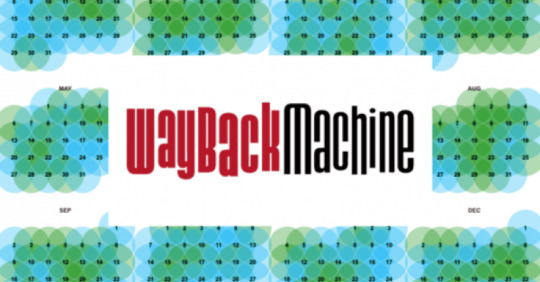
I'm at DEFCON! TODAY (Aug 10), I'm giving a keynote called "DISENSHITTIFY OR DIE! How hackers can seize the means of computation and build a new, good internet that is hardened against our asshole bosses' insatiable horniness for enshittification" (noon, LVCC - L1 - HW1–11–01).

#5yrsago As police scrutiny tightens, Hong Kongers use Tinder and Pokemon Go to organize protests https://www.scmp.com/abacus/culture/article/3021560/how-hong-kong-protesters-are-using-tinder-and-pokemon-go
#5yrsago Group sex dating app has “the worst security for any dating app” https://www.pentestpartners.com/security-blog/group-sex-app-leaks-locations-pictures-and-other-personal-details-identifies-users-in-white-house-and-supreme-court/
#5yrsago Six charts that illuminate the state of US immigration https://www.bbc.com/news/world-46034400
#5yrsago The NRA spent $70,000 on a consultant to help Wayne LaPierre choose which mansion to purchase https://www.propublica.org/article/documents-show-nra-money-helped-chief-wayne-lapierre-search-personal-mansion
#5yrsago Uber projected $8b in losses for 2019, but it just booked $5.2b in losses in a single quarter https://www.theverge.com/2019/8/8/20793793/uber-5-billion-quarter-loss-profit-lyft-traffic-2019
#5yrsago RIP, Linux Journal https://www.linuxjournal.com/content/linux-journal-ceases-publication-awkward-goodbye
#5yrsago Barnes and Noble’s new boss is James Daunt, who rescued the UK’s Waterstones https://memex.craphound.com/2019/08/09/barnes-and-nobles-new-boss-is-james-daunt-who-rescued-the-uks-waterstones/
#5yrsago Facebook has filed a laughable patent-application for the well-known practice of “shadow banning” https://memex.craphound.com/2019/08/09/facebook-has-filed-a-laughable-patent-application-for-the-well-known-practice-of-shadow-banning/
#5yrsago Florida police admit they will not be able to recover gun stolen during masked orgy https://www.nydailynews.com/2019/08/08/gun-stolen-during-anonymous-masked-orgy-police-admit-were-probably-not-going-to-solve-this-one/
#5yrsago The voting machines that local officials swore were not connected to the internet have been connected to the internet for years https://web.archive.org/web/20190808184605/https://www.vice.com/en_us/article/3kxzk9/exclusive-critical-us-election-systems-have-been-left-exposed-online-despite-official-denials
#1yrago No, Uber's (still) not profitable https://pluralistic.net/2023/08/09/accounting-gimmicks/#unter

Community voting for SXSW is live! If you wanna hear RIDA QADRI and me talk about how GIG WORKERS can DISENSHITTIFY their jobs with INTEROPERABILITY, VOTE FOR THIS ONE!
2 notes
·
View notes
Text
Optimizing Performance on Enterprise Linux Systems: Tips and Tricks
Introduction: In the dynamic world of enterprise computing, the performance of Linux systems plays a crucial role in ensuring efficiency, scalability, and reliability. Whether you're managing a data center, cloud infrastructure, or edge computing environment, optimizing performance is a continuous pursuit. In this article, we'll delve into various tips and tricks to enhance the performance of enterprise Linux systems, covering everything from kernel tuning to application-level optimizations.
Kernel Tuning:
Adjusting kernel parameters: Fine-tuning parameters such as TCP/IP stack settings, file system parameters, and memory management can significantly impact performance. Tools like sysctl provide a convenient interface to modify these parameters.
Utilizing kernel patches: Keeping abreast of the latest kernel patches and updates can address performance bottlenecks and security vulnerabilities. Techniques like kernel live patching ensure minimal downtime during patch application.
File System Optimization:
Choosing the right file system: Depending on the workload characteristics, selecting an appropriate file system like ext4, XFS, or Btrfs can optimize I/O performance, scalability, and data integrity.
File system tuning: Tweaking parameters such as block size, journaling options, and inode settings can improve file system performance for specific use cases.
Disk and Storage Optimization:
Utilizing solid-state drives (SSDs): SSDs offer significantly faster read/write speeds compared to traditional HDDs, making them ideal for I/O-intensive workloads.
Implementing RAID configurations: RAID arrays improve data redundancy, fault tolerance, and disk I/O performance. Choosing the right RAID level based on performance and redundancy requirements is crucial.
Leveraging storage technologies: Technologies like LVM (Logical Volume Manager) and software-defined storage solutions provide flexibility and performance optimization capabilities.
Memory Management:
Optimizing memory allocation: Adjusting parameters related to memory allocation and usage, such as swappiness and transparent huge pages, can enhance system performance and resource utilization.
Monitoring memory usage: Utilizing tools like sar, vmstat, and top to monitor memory usage trends and identify memory-related bottlenecks.
CPU Optimization:
CPU affinity and scheduling: Assigning specific CPU cores to critical processes or applications can minimize contention and improve performance. Tools like taskset and numactl facilitate CPU affinity configuration.
Utilizing CPU governor profiles: Choosing the appropriate CPU governor profile based on workload characteristics can optimize CPU frequency scaling and power consumption.
Application-Level Optimization:
Performance profiling and benchmarking: Utilizing tools like perf, strace, and sysstat for performance profiling and benchmarking can identify performance bottlenecks and optimize application code.
Compiler optimizations: Leveraging compiler optimization flags and techniques to enhance code performance and efficiency.
Conclusion: Optimizing performance on enterprise Linux systems is a multifaceted endeavor that requires a combination of kernel tuning, file system optimization, storage configuration, memory management, CPU optimization, and application-level optimizations. By implementing the tips and tricks outlined in this article, organizations can maximize the performance, scalability, and reliability of their Linux infrastructure, ultimately delivering better user experiences and driving business success.
For further details click www.qcsdclabs.com
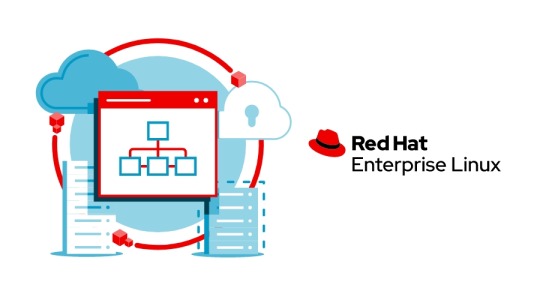
#redhatcourses#redhat#linux#redhatlinux#docker#dockerswarm#linuxsystem#information technology#enterpriselinx#automation#clustering#openshift#cloudcomputing#containerorchestration#microservices#aws
1 note
·
View note
Text
I'll have to consider a Google break-up. But this reminds me how I did just go through separation with Microsoft 365.
My very first step was listing out all the places where I use Microsoft and thinking through what my requirements were for replacing them. OneDrive, for the longest time, was my sticking point. This program has saved me twice now when I've had computer issues. I needed something that would keep copies of my files in the cloud, connect with multiple folders, sync instantly, and connect with my phone. I also wanted to pay no more than I was already paying for Microsoft 365. Finally, it had to be easy to use.
For the Office Suite, I just needed something that could open and edit my Microsoft files and have similar features. I rarely use Word/Excel/etc outside of work, though that may change if I do breakup with Google (I use Google Sheets for myriad things).
OneDrive
To replace the online drive and sync, I've switched to pCloud. It isn't free, though. It costs $50-60/year for 500GB (and about a $100 for 2T).
Steps for switching:
Make sure you have downloaded everything from OneDrive to your computer. Most of your files actually live in the cloud and you'll lose access to them when you uninstall OneDrive (note: they'll still be online).
Move all of your files into your User directory or somewhere else on your computer that isn't your OneDrive folder. (Learn from my mistakes...)
Uninstall OneDrive.
Go through your files and delete all of your OneDrive folders.
Download and install pCloud and follow their directions.
(Note: pCloud does have a OneDrive import feature, but I did not use that and I do not know how well it supports uninstalling OneDrive afterward.)
I also have pCloud on my phone now. I don't know if I just have rosy glasses on, but it feels nicer than the OneDrive app.
(Note: I do not rec NextCloud. I tried it and was met with nothing but pure frustration. Plus, for basic sync, I learned I had to download another program/extension, but then it was super unclear on how to install that extra bit and etc etc etc.)
ETA: OneDrive will still exist in some pretty critical default filepaths (e.g., your desktop folder). I followed this to fix it in my registry.
Office Suite
I've downloaded LibreOffice (free!)for this. If your Calc is an utter glacier when you open it, look up how to check the "Force Skia software rendering" box. That fixed the issue for me.
If you prefer ribbons over menus, there is a view option for that, too.
I am also currently trialing Typora, which costs $15 and is beautiful. It is a Markdown editor in which your Markdown is instantly rendered.
Other Microsoft Apps
I don't tend to use other Microsoft apps much outside of work. If I used a desktop email client, I'd probably go back to Thunderbird, which I used back in college.
As for OneNote, I'm not sure. Obsidian, which I use for my worldbook for my current story, is fantastic, but I've not tried to have different projects on it at once.
For teams, there's Slack and Discord. For the Sharepoint side of teams, maybe Box, Basecamp, or Confluence? I've not really looked into this because I don't use Teams in my non-work life and there is a 0% chance my workplace transitions away from Teams and Sharepoint anytime soon.
For Notepad, Notepad++ has always been one of the first programs I download to new computers. It is stellar.
For other apps, I'm already using alternatives (e.g., VLC Media Player, Firefox, WonderShare) or they aren't programs I even knew existed (e.g., Journal?, Family?). A few, though, just feel like system tools (e.g., Snipping Tool, Calculator).
Of course, there is the Linux of it all.
I have considered linux before. I have even tried linux (Ubuntu) before.
Most of what I use these days will work with Linux, with one major and rather important-to-me exception: Scrivener.
I am yet to find a single other application I like half as well as Scrivener.
Just in time for Valentine’s Day... 💔
Ready to break up with Google?

So are we!
We’ve rounded up a bunch of privacy-centric alternatives for everything Google.

Check out the full list over on the blog!
- The Ellipsus Team xo
49K notes
·
View notes
Text
Freedom GPT: A Comprehensive Overview

What is Freedom GPT?
Freedom GPT is an AI chatbot developed by GPT-Age of AI, LLC, known for its commitment to unrestricted communication. It is a versatile linguistic model designed for tasks like:

Content generation
Language translation
Creative writing
This chatbot ensures functionality without requiring jailbreaking, making it a user-friendly tool.
Why Was Freedom GPT Created?
Freedom GPT was created to emphasize the significance of uncensored AI. It stands out for its strong privacy protection and ensures:
Respect for user privacy
Prevention of unauthorized sharing of thoughts
In the Age of AI, individuals and businesses need exclusive AI models. Freedom GPT supports companies across industries in achieving this goal.
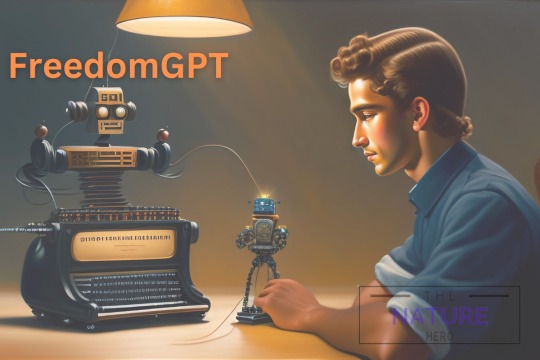
Is Freedom GPT Dangerous?
Freedom GPT is not inherently dangerous. Ensuring AI safety requires:
Systematic approaches
Transparency
Censorship limits free speech. Instead, open safety management reflects the importance of careful training to prevent unintended outcomes.
How Freedom GPT Works
Freedom GPT operates using Alpaca models developed by Stanford University. Here’s how you can use it:
Install the Freedom GPT Desktop App: Download and install the app on your computer.
Select an AI Model: Choose from models like ALPACA 7B FAST, ALPACA 7B FULL, LLAMA 7B FAST, and LLAMA 7B FULL. ALPACA 7B FAST offers quicker responses, while ALPACA 7B FULL is slower but more detailed.
Download and Launch: Allow the model to download. Once complete, click "Select" to begin chatting.
Switch Models Anytime: Experiment with different models to suit your preferences.
Key Features of Freedom GPT
Uncensored conversations with no restrictions on questions or content.
Privacy and security, running on your device without third-party servers or internet connections.
Offline functionality without internet reliance.
Customizable AI with open-source versions for businesses.
Pros and Cons of Freedom GPT

Pros:
Generates original and creative content.
Automates content creation, saving time.
Ideal for producing marketing, journalism, and entertainment materials.
Cost-effective by reducing the need for additional writers or editors.
Supports multiple languages for global communication.
Cons:
Risk of plagiarism if unsupervised.
Content may lack emotional depth or personal touch.
Over-reliance could hinder human writing skills.
Can generate incorrect or biased information if not validated.
Potential for unethical use, like spreading misinformation.
Downloading and Installing Freedom GPT
Follow these steps to install Freedom GPT on your device:
Visit the GitHub repository.
Click "Code" and select "Download ZIP".
Extract the ZIP file to a folder on your computer.
Open the folder and run the command: yarn install.
Use the command: yarn start:prod to launch the application.
System Requirements for Freedom GPT
To run Freedom GPT effectively, ensure the following:
Processor: Intel processors with AVX2 support (some AMD CPUs may also work).
RAM: Minimum 8 GB (recommended 10+ GB).
Storage: SSD is essential for proper model loading.
Operating System: Compatible with Windows 10/8.1, Linux, and Mac.
GPU: Not a significant factor for local performance.
Benefits of Freedom GPT
No censorship allows unrestricted questions, even sensitive ones.
Privacy ensures all data remains on your device.
Offline capability without requiring an internet connection.
Versatile applications, including text generation, language translation, creative content creation, and informative responses.
Chat GPT vs Freedom GPT vs Bing AI
Chat GPT is developed by Open AI and is known for its safety measures and ethical guidelines. Freedom GPT, created by Age of AI, focuses on uncensored interactions and offline functionality. Bing AI, from Microsoft, is integrated with Bing Search for tailored online solutions.
Chat GPT emphasizes safe AI practices, Freedom GPT prioritizes privacy and flexibility, and Bing AI provides seamless search integration.
0 notes
Text
[A little taste of] The joy of Linux
Day 25 - Nov 30th, 12.023
This is a little premise for a post that I hope to do in the future to talk more about the topic. But for the time being, this is a "little preview" on how I utilize my Operating System (OS), Linux, daily and how I think it is has more advantages outside just development work.
Pomodoro timer
If you read the last entry of the daily journal, you remember that I was in need of some sort of pomodoro timer. I already tried researching for
one some time ago, but never found one that satisfied me. Most of the ones you find for Linux use outdated technology, look, or don't integrate easily with your environment. I have one installed on my cellphone, however I completely forgot about it yesterday, and now it's too late to go back. And I wanted one just to remember myself to take a break or so, with sound and notification when the time finishes.
So I researched again for pomodoro timers on Linux, and seeing one of the results, a concept returned to my mind: creating a timer just using the terminal and Bash.
The result was this video:
youtube
And seeing the code that she used, I was impressed:
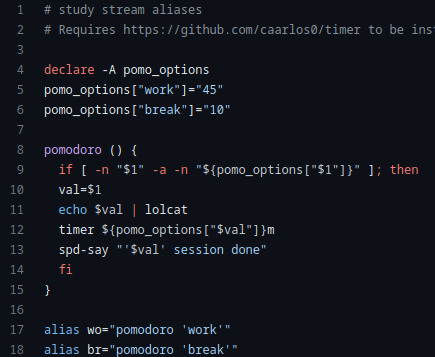
Link to the original code
I know that if you don't know how to code it is complete gibberish, but you can deny that it is small and simple, and just a ctrl+c ctrl+v away of using. That is what took to have a simple pomodoro time in your system. No installation, no term of services, no privacy policy checkbox, no login, no setup. Just create one file, paste it, run it, and you're good to go.
That's what I love when about using Linux, you can easily create your own tools. Or just copy, paste, and tweak some things if you don't know how to code or basic scripting (which to be honest, you should, even on Windows, but that's a talk for the future).
Bash everywhere
"But what is bash?", well, in simple words for someone who doesn't know how to code, it is a simple programming language that you can run from your terminal or turn into an executable to run when you click the file. It comes built-in in every Linux system, and macOS too, I think. And in simple terms, it just lets you automate some boring things like opening apps, moving files, etc. and run commands.
"That's it?", yes. "So why it is so special?", well, again it comes built-in, so you don't need to install anything, and it can run any command that there is on Linux. And when you match some bash scripts and the extensive list of Linux commands and CLI tools… you can pretty much automate everything and run it from one command.
And that's what I did. As an example, with bash I created some scripts that enable me to switch environments with just one command:
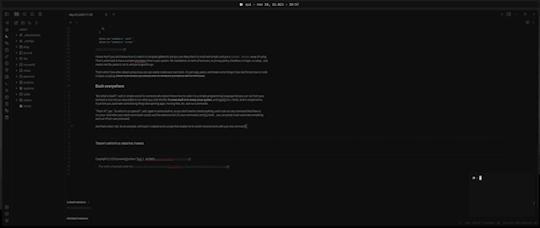
I unfortunately can't record both screens, but in summary, what this command does:
Close active windows from current environment;
Opens programs for the new environment;
Changes the look of the OS, wallpaper, etc.;
And in the case of the coding environment: opens the browser for preview, browser for documentation and text editor.
And I still plan to in the future add the feature of opening software from the past session in each environment, so I can continue my work from where I left.
All of it was written in pure bash, no dependencies outside what already is in my [customized] operating system. And just a note: I changed the system that handles the programs window (the Window Manager), to one that I can navigate completely with the keyboard and remove the distraction to make it the most clean possible. On Linux, you can pretty much remove the entire OS part by part that it doesn't't care or stops you.
And the pomodoro timer?
Well, I customized it a little to be more in touch with my OS and also add custom sounds for it. But again, I just use one command for it:
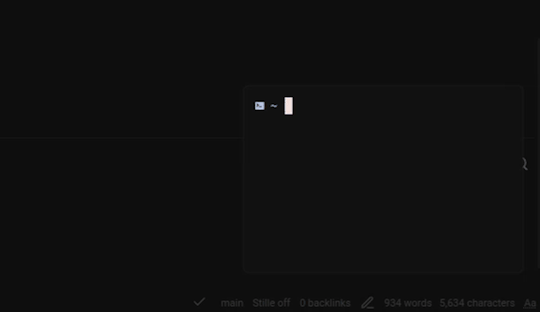
That's it, it just opens another terminal where the timer runs and when it finishes and the bar is at 100%, the terminal closes and a sound is played and a notification sent.
If you want the code I probably will post in my @guzscode showing it better, but if you want it now, here is my dot files and the pomodoro timer script. I still want to add some things to it, like sending notifications to my phone when the timer finishes and things like that.
---
I hope that this shows at least one of the things that I like about Linux, and how I think it lets you do a lot more than you could in other OSes.
---
Today's artists & creative things
Album: Herói do Futuro - by O Grilo I already recommended a music from this album, but I now listened to it more, and it's a bop. To be honest, I don't have a lot of opinion about it, I like the guitar and style in general. It is just good, y'know?
---
Copyright (c) 2023-present Gustavo "Guz" L. de Mello <[email protected]>
This work is licensed under the Creative Commons Attribution-ShareAlike 4.0 International (CC BY-SA 4.0) License
1 note
·
View note
Text
Linux Performance Tuning and Optimization
Red Hat Certification, Linux performance tuning and optimization are essential for maximizing the efficiency and responsiveness of a Linux system. Here are key strategies and considerations:
Monitoring Tools: Use performance monitoring tools like top, htop, and vmstat to identify bottlenecks and resource utilization. Tools like sar and Prometheus can provide historical data for analysis.
Kernel Parameters: Adjust kernel parameters via the /proc file system or configuration files in /etc/sysctl.d to optimize system behavior. Parameters like vm.swappiness, fs.file-max, and net.core.somaxconn can impact performance.
File System Optimization: Choose the right file system for your workload (e.g., ext4, XFS, or ZFS). Tune file system options like block sizes, journaling, and mount options for your specific use case.
I/O Optimization: Use hdparm or fio to test and optimize disk I/O. Implement techniques like RAID and SSDs for improved disk performance. Set read-ahead and I/O scheduler options appropriately.
Memory Management: Adjust memory settings, such as swappiness and transparent huge pages, to optimize RAM usage. Use vmstat to monitor swap activity.
CPU Tuning: Configure CPU governors to manage CPU frequency and power usage. Tools like cpufrequtils and tuned help optimize CPU performance.
Network Optimization: Tune network settings like TCP congestion control algorithms and buffer sizes. Tools like ifconfig and ethtool can help manage network interfaces.
Service Optimization: Review and optimize services running on your system. Disable unnecessary services, and configure service parameters for efficiency.
Security Measures: Implement security best practices to protect against resource-intensive attacks, such as denial-of-service (DoS) attacks.
Load Balancing: Use load balancing tools like HAProxy to distribute workloads across multiple servers for better performance and redundancy.
Web Server Optimization: For web servers like Apache or Nginx, adjust settings, such as worker processes and connections, to handle varying loads efficiently.
Database Tuning: Optimize database performance by configuring indexes, query caching, and buffer pool sizes. Tools like mysqltuner can assist in database tuning.
Regular Maintenance: Schedule routine maintenance tasks like disk defragmentation, log rotation, and software updates to prevent performance degradation over time.
Benchmarking: Periodically run benchmarks and performance tests to evaluate the impact of changes and improvements.
Documentation: Maintain documentation of changes and configurations to track the impact of optimizations and facilitate troubleshooting.
Performance tuning and optimization in Linux are ongoing processes that require monitoring, analysis, and adaptation to meet the specific requirements of your system and workloads. Regularly review and adjust configurations to ensure optimal performance.
0 notes
Text
re drivers: they're specific to the operating system! your Linux install absolutely could have non-working drivers while your Windows system has working ones.
re the general Manjaro and Thinkpad situation: I ran Manjaro for a while, but kept on getting lockups or kernel panics (probably what you're experiencing, the screen is frozen and the caps-lock key is blinking) very frequently. I think it's a general problem with Manjaro using very new, experimental versions of the Linux kernel. Now I've switched to Debian, and I have yet to experience a kernel panic after years of use. Debian software is a little older but the stability is well worth it for me.
re options for getting a system that works: when I was using Manjaro, there was an option in the boot screen (the GRUB menu) to boot from older kernel versions. Not sure if you have that, it might be under an "advanced options" thing. Usually I could find something four or five versions back that was stable and worked okay. You will probably be fine with the second-newest version (if the newest version is the only one that crashes).
re info/logs/etc: there are a few commands for this. For a lot of output about hardware, you'll want to install and run lshw (terminal command). You can redirect the output into a file: "sudo lshw > lshw-output.txt" (then you can share the file with people). For crash logs, run "sudo journalctl -b -1" (this will show you the system journal from your last boot, start-to-finish.) There will be lots and lots of output; it might be better to run "sudo journalctl -b -1 --no-pager > journalctl_log.txt" and then look at the resulting text file later. You can send me the file (put it on pastebin and send a link) and I can highlight the relevant portion for the issue you're facing, if you'd like. Also feel free to DM me with any other questions.
general strategies/tips n tricks: if I were you, I would create a bootable live Debian ISO (not just an installer) from Windows and boot off of it. It won't install anything on your disk, it just lets you take a look around in a stable Linux environment. You can run lshw from there, but the listed drivers will be different than the ones you're using on Manjaro (still very helpful for knowing exactly what hardware you have!) You can also run journalctl commands with a flag that points them at a certain partition (your Manjaro one) and they'll grab the journal off of the disk! And you can mount your Manjaro partition and look at config files, log files, etc. All in all a good diagnostic tool.
Does anyone know anything about Linux, specifically the Manjaro distro on a Lenovo ThinkPad? My distro stopped working entirely last week when I got back from my trip. I've tried researching it but I'm not having much success. The distro will boot but then freeze entirely within a minute or two. I have a dual-boot; I'm actually currently on my Windows 10 OS. (I really miss the tools that I had on Manjaro to unfuck my Tumblr dash. T_T) I thought perhaps the issue was my video driver, but wouldn't that mean that my Windows 10 OS wouldn't work either? And I don't know how to adapt kernals, especially if my Manjaro distro won't even stay operational long enough to get to the settings. Every Linux forum asks for computer stats but, other than the basics like brand etc., I don't know how to find those either.
I want to solve this myself but it's become so frustrating.
4 notes
·
View notes
Text
How I envision Servitor rn

Tbh, I just throw the fictional / fantasy part out of the window and integrate the ideas from other fictions of mine into it because now it is a manifestation game. Why? Because I am so sick of waiting for scripting my wishes individually and awaiting to see them manifest over eons that may as well.
Basically stems from my very own manifestation prompt: "What if one went on to edit the entire world just like a file system like Git?"
So ya, it is great storytelling & game dev material because I envision a full narrative of empowerment and rags-to-riches-style existential "Matrix" escalation intrigue out of such. Nothing horrendous much, just plain handsome comfy vibes.
[INSERT AGENT PICTURE#1 HERE]
Wishlist
Female biological gender
Name changed to Klara
Female pronouns & conjugations
Twin brother Deno
Born in 2000 brother Wyatt
Me being born in 1996 alongside my twin brother
Finished media studies in Cegep and seeking entry-level career options in the field
Bookstore clerk part-time job
Father Gustav Hayden being emotionally respecting and staying such (so no abuse of power or anything manipulative...) as well as still encouraging me in my retro + modern computing endavours
Mother Falah Becker being polyglot, making more income by herself and succeeding much in her career
Having overall better teenage years (less stagnation at my earlier middle school, stronger social life and more skill-development portfolio successes during such part of my life)
Personal adulthood backstory changes (fully finished College in media studies, stronger friend network and getting a great handsome career)
Still having my very own DSi and its library albeit now homebrew hacked, customized and jail-broken
Nintendo N64 game console
Dreamcast game console with fitting VMUs
Awesome-r home appartment and familial autonomy (more liberty at home and less... oppression)
Wardrobe changes (soft retro grunge somewhat androgynous fem wardrobe)
Ethical personal Tumblr blog since ~2013
2014 Linux home workstation
iMac 24" maxed-out
iPhone 12 mini
Having Shoshona the housecat like how I imagined her
Strong friend group
Maybe more technology certificates?
Aesthetic programmer lady stereotype?
Photographic memory
Volkswagen Beetle car of my very own that is electricity-powered
Customized bicycle of my very own for summer & winter alike
Poetry writing / journaling / note-taking habit since youth
World geography change [see to-be-revised tectonics map above]
Maybe some solar system changes? but only minor ones.
Living in the Shoshone Union as a natural citizen of such
Theodore Roosevelt winning the 1912 election and then Charles Hugues in 1916 so no Wilsonism into the mainstream (aka no Woodrow Wilson presidency)
Computing technologies arising from the early 1920s onwards
Pflaumen (hardware symbolic-processing firm) & Utalics (software symbolic-processing firm) being market leads in the more traditional 'workshop' computing market
EBM, Macroware and many other firms participate in agentive synthetic systems' design
Left ideologies: Syndicalism wins big time as Lenin never got to infect the left
Right ideologies: Georgism is implemented and moderate capitalism still continues in nice harmony with syndies thanks to Charles Hugues' successor successful harmonization of lobby groups during the early 1920s
1904-1907: Great War (A quick war similar to WW2 where the Shoshone Union asserts their worldwide benevolent hegemony as they strike down the resistance within the Mayan Republic, making the hegemon a caring benefactor as they strike a better balance henceforth)
1840-1848: Great War (Horrendous trench warfare on land and overseas, leading to introspection and softened social welfare policies)
1920s beign a time of radical knowledge development to be formalized very gradually towards the later 1980s global telecommunications network.
Synthetic serfs commercially available in the year 2000, with consistent robotic serfs lineup dev since the 1960s and sophisticated droids since the later 1980s
Nanotechnology, civil rights upgrade by the morphological freedoms chart since the ~1992-1994 act
Affordable bio-modding becoming available by the mid-2010s
More empowering baby boomer revolution (later 90s-early 2000s instead of the 60s) that has a way more positive long-term everlasting legacy than what we got with baby-boomers
Nuclear weapons only became a peaceful derrogative much later, around ~1996 AD equivalent
Shifting destination being around 2020 AD eq.
Far far way retrofuturistic feeling world tech-wise with a everglowing solarpunk positive vibes for lively standards (still has a realistic/cohesive history log but yk, it feels plain nicer to live in)
Analog computing staying alive and carring on very well alongside digital computing, developping synergies between both
Softer relations between religions leading to shared doctrines, becoming a broader and broader generic framework as centuries of work build-up
Slower but everlasting equality progression for women and other sapients
1940s' 45rpm autoplay vinyls -> early 70s' large laserdiscs -> mid-sized optical media UTO disks from the late 80s
Tribble data as default data word instead of bytes (evolved from a few 6-bit standards encoded together, enabling easy multilingual code paradigm early on)
Also easy full-stack disk editors and libre hacker mentality creating a skill boom, leading to lesser and lesser prices (price war), leading to a vast library of libre software shared among many that empowers commonfolks and developers alike. (somewhat like in Russia's software tech market but on both ends instead of mostly just the software side)
Larger history changes ()
[...]
'Realis' changelog [to be written]
(?)
2 notes
·
View notes
Text
My Writing Tools
I am in the humanities and I write. I don't really like Word, though. Google Docs makes me feel trendy enough but even that is too word-processory. Basically, I wanted to adopt a writing platform that felt unique to me, and that freed me from conventional software that writers in my field use. I also wanted it to be simple and pared down. In this post, I'll talk about what I worked out.
The Software
Currently, I'm working with four essential programs:
Vim (the "ubiquitous text editor")
Pandoc
Dropbox
1Writer
"Vim," also called "Vi" (if you're working in an older terminal) and "gVim" (a GUI version) is a text editor with an extremely long history. I don't exactly understand that history in its entirety, but I do understand that the program's functionality and functions haven't changed for something like thirty years. There are a lot of people (and by "people" I mostly mean "programmers") who don't like Vim. But those who do like it say three things about it: it has a steep learning curve; but once you've learned it you'll never have to learn anything again; and it's blazingly fast at editing text.
Out of the box, Vim is very bare-bones. This is nice if you are like me (bells and whistles are distracting to you).
Vim is installed with most mac and 'nix systems by default (is my understanding).
Vim is only a text editor. You can't edit the kinds of files we work with in the humanities (.docx, .pdf, etc.). That's where the protocol for my new writing system comes in.
Markdown
Markdown is a "markup language." What this means in practice is that certain text symbols designate that text should have certain properties.
For example, if you put the "#" symbol at the beginning of a line, markdown will understand the text that follows to be heading level one.
If you surround a word or phrase with asterisks, it will be in italics.
Why does this matter? It doesn't, really, unless you adopt Pandoc, as I have, or (apparently) LaTeX, as some (most?) writers in the sciences have.
Basically: markdown makes text formatting into a matter of written symbols instead of a series of clicks. Instead of clicking "italicize" (or hitting CTRL+I), you type asterisks around the text you wish to italicize.
The outcome of this is that a variety of programs that understand how to interpret markdown's symbology can represent your text.
Pandoc
Let's say you've read all about markdown and have adopted it into your writing practice. Now you've written some stuff and you want to send it to a professor or an academic journal -- and they want a Word document.
That's where Pandoc comes in. It converts the markdown text file into a Word file. Or a PDF. Or whatever it is that you need.
Pandoc + Vim
Because it is aimed at programmers, Vim has the "make" command, which normally would compile the code you are writing. Obviously I am not compiling code, but I can set Pandoc as the compiler in my .vimrc file (which holds my vim settings.
set makeprg=pandoc\ -s\ -o\ ~/Dropbox/newfile.docx\ % set encoding=utf-8
Line one does a couple of things: it sets the compiler to Pandoc and it specifies the destination for the output file. I set that file to be named "newfile.docx," which is a good practice because it means I have to open it and make sure everything looks good before renaming it and moving it to an appropriate directory.
Now I can type ":make" into Vim and my word document will be created.
Pandoc and Templates
Pandoc converts to Word according to a template. There's no way to explain how setting this up went for me except: it was god-awful. The documentation sucks. I don't know if I would actually be able to replicate how I got it worked out, or even to explain it. But I eventually succeeded, and I'm happy.
Dropbox
I don't think anyone can do anything without the cloud these days. I don't really like Dropbox all that much, but I like having native apps for the cloud, and Dropbox is the only one with cross-platform capabilities (I have a linux desktop, a windows laptop, and an iPhone, because I am an idiot).
To use Vim's "find" command, I set my .vimrc to look in Dropbox by default:
set path+=~/Dropbox/**
Dropbox and Clear Thinking
This is an area I would like to improve on. Currently, I organize my sub-folders by topics, which are basically just the courses I am taking. I would like, instead, to use the PARA method. So that's an ongoing issue -- perhaps for another post in the future.
Maybe PARA isn't quite right, but I do think that my current way of saving and organizing everything could be more consistent, and more effectual at helping me find old ideas more quickly.
1Writer
Lastly, I have 1Writer on my iPhone. It cost something (maybe $4.99?), but I think it was worth it. You can edit markdown easily and quickly, and you can also preview it. I like typing up a bunch of notes at home, then reviewing them during my commute on my phone in 1Writer's attractive interface.
2 notes
·
View notes
Text
Behind the Scenes of System76: Customer Happiness Team
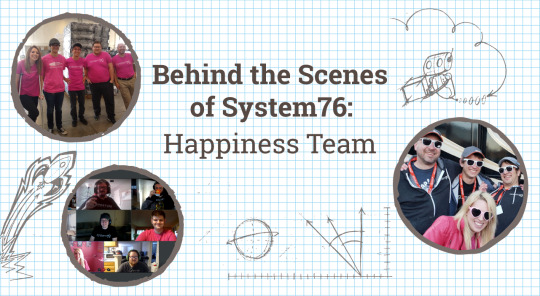
In this installment of our Behind the Scenes series, we spoke with head happiness guru Emma Marshall, an enthusiastic Linux, pink, and T-Swift enthusiast who helms the Support Team. Read on for an inside look at the methods—and the madness—of System76’s tech support crew.
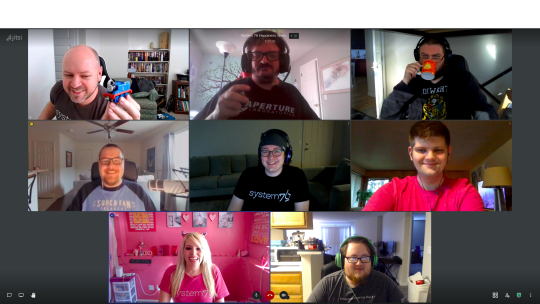
First off, let’s talk a little bit about the Customer Happiness Team’s role at System76.
We handle the customer experience after the sale. We want our customers to know that we care about them, and we make sure that they’re feeling like they’re getting the attention they deserve when they do have a problem. We also make sure that they’re happy at the end of their solution.
If a customer has a specific complaint, or if we see something that hasn’t been communicated correctly that gave them a wrong impression, then I communicate with the other departments in a productive and positive way so we can get to a better solution as a company. So I report things to QA, we get bugs filed and handled, and we ask questions to engineering when we don’t know how to fix something. We try to collaborate as efficiently as possible.

As the head of all things Happiness, what is your approach to the process of providing support?
We have this little acronym, it’s the H.A.P.P.Y. approach to tech support. The H stands for Human. Instead of using scripts and sending out links every time, we’ll put the actual solution in the ticket and we’ll greet them with empathy and their name. We don’t have any automated things happening in there. Nothing is robotic in tech support. Everything is handled by a human.
The A is for Active, meaning we keep the tickets active until they’re resolved. So if a customer has gone quiet, or if a repair tech has gone quiet, we make sure to ping them constantly until the problem is 100% taken care of.
The first P is for Positivity, which helps keep our customers and our team happy, and the second P is for Productive - we want to keep our queue moving as quickly as possible. We don’t want to ask questions that aren’t relevant to the case. We want to keep customers on the track of being productive as well, so if they’re focused on voicing negativity, we try to steer the conversation in a more productive direction to keep everyone focused on reaching a solution.
And then the Y is for You. We encourage everyone on the team to be their nerdy selves, so if a customer mentions something they love, they can chime in and nerd out with the customer for a few minutes and have that little touch of their personality to the call or to the ticket. So that’s our H.A.P.P.Y. approach to tech support.
This year was the System76 Care Team’s “happiest” year on record. What do you think made it so successful?
It’s a combination of the work of everyone in the company. I think we have a mix of really good products, incredible engineering, a QA team that caught potential issues before shipping products, and a sales team that provided the right information so the customer purchased the best product for them. And then a support team that made sure things were solved quickly and happily at the end. That’s what we strive for every year! I also have an epic team right now.
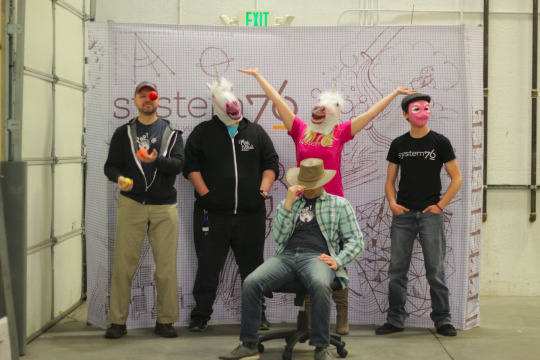
How would you describe you and your team’s backgrounds in Linux?
They’re all Linux fans. Two of them are customers, and one of those customers is a SuperFan! I used to have another Superfan on the team, so that seems to be a trend for us. Two guys on our team did tech support for colleges, so they have server and sysadmin backgrounds, and then we have two team members with customer service backgrounds as well.
I actually met Thomas at a Linux conference when he was still a customer service rep for an office supply company. He was clearly like all of us: a complete nerd. He just naturally fit. We all have our nerdy quirks and come from very different backgrounds, but combining our knowledge and collaborating helps us solve the tickets with the same quality. The individuality on the team is what makes it so fun!
I went to school for journalism and worked for a couple newspapers. Then, I had a customer service job for a couple of years. After that I came to System76. Actually I just reached 9 years of working at System76 today! I’ve done every single role at System76 basically, besides being an engineer. My last positions were a combination of customer service and communication. Communication is by far the hardest part of my job, so that experience has really helped me gain better communication with everyone across the company.

How do you ensure your team stays close amid the chaos?
We all do game nights together. We have a really tight bond as a team, which I think really contributes to our success.
Are there any new “features” planned for the Care Team in the near future?
A major focus for this year is one-and-done tickets, as well as cutting down on response times. We want to get everything we can in the initial message to the customer to hopefully get a solution accomplished within one message. The team has been doing a contest the past couple months, and it is amazing how many tickets they can get one-and-done. So I know we can do that sort of motivation work a lot more often to get tickets solved quicker, and have less in the queue for longer periods of time. It’ll be awesome.
Any advice for people looking to start their tech career in a support role?
I think it’s important to have a customer service background. And I mean any customer service, even working at a retail store. Being a human and putting yourself in other people’s shoes is such an integral part of being a tech support technician. Anything where you have to communicate with other people for a year. At least get some of that under your belt.
And if you’re a hobbyist, just keep learning. Learn everything you can all the time. You can’t know enough as a tech support rep, and you have to always be curious. Be curious about the problem and be curious about the solution. You have to have a desire to always want to find answers and find new ways to fix things.
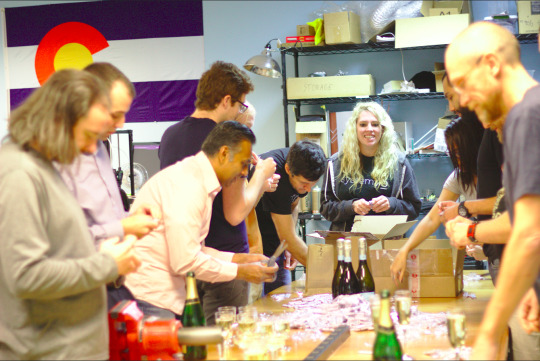
You’re one of System76’s longest-running staff members. What’s it been like to watch the company grow?
It’s been unreal. Amazing. It actually makes me tear up a little because I couldn’t be more proud of a project that I’ve been a part of, you know? It’s been very cool watching Carl as an owner and as an innovator. To have someone that inspires you so much, and to be able to be part of their project as well makes me not want to go away. I can’t wait to see what’s going to happen next. That’s the best part.

Do you have a favorite moment?
I have two. Wait… I have a lot. But I’ll try to keep it to two. The Pop!_OS release in 2017, when we released the operating system and were flashing USBs, like hundreds of USBs in this side room. We were in an office building, but we were actually starting to try to manufacture things with a laser in this side room that had black curtains so no one could see what we were doing in there. So all of us bunched into this really small room and we popped champagne bottles and they were flashing the USBs. They were all over the table. It was so cool. I think we all got a little tipsy that day. Maybe a lot tipsy, actually.
Then we had our first million dollar month. That was when our office was downtown. It was a day of celebration for everyone. It was the realization of how big we’d become. There was so much laughing and excitement, and we were a small, tight-knit team at the time. I remember that day feeling like, wow, we’re really doing well. That was a really cool feeling.
Do you miss being at the office?
Oh yeah. I think it gets to me some days. I miss everyone, and I just want to be around people. I want to go bug Bjorn, or make people smoothies, or flip some hamburgers or bring lunches. I want to do all that fun stuff that I used to, but now I’m having to try to manage that remotely. But the video calls, those help.
The game nights help as well. We used to do those in person, but we can’t really do them in person right now so I’m having to settle with remote things. It’s been rough, but it’s something we’ve got to deal with, just like everything else. So deal with it with a smile and we’ll get through it.

What’s your favorite cat gif?
I have a lot. Fixing time clocks is an annoying little task. Sometimes the time clock we use just poops and doesn’t work right, so my rule is any time I have to fix the time clock for a team member, they have to send me cat gifs. That’s their payment. So I get quite a few cat gifs every week. In our team chat, any time I’m upset about something, the cat gifs come in a waterfall.
The one that really sticks with me is the cat with the pink wig on, and a headset, typing on a computer. I saved that one myself.
I can’t help but notice I’m in a couple of these photos.
You’re one of us, Alex. Just accept it.
#linux#tech#technology#support#support team#care team#technical support#system76#s76#76#desktops#laptops#servers#hardware#software#firmware#science#computers#computing#computer science#coding#ai#machine learning#deep learning#protein folding#bioinformatics#gaming#cybersecurity#engineering#cat
3 notes
·
View notes
Text
Great idea! I’d actually thought about this before, and you convinced me to try it out. So, I modified the command to this:
sleep 60 && sudo bash -c 'echo "0" > /sys/bus/pci/devices/0000\:01\:00.0/d3cold_allowed'
Doing this changed the result… to something new… again. Now the machine brings me to the unlock screen, and it functions as normal. I can type in my password and hit enter. The loading pinwheel then appears beside the password box and the entire system freezes for 1-2 minutes, maybe longer.
After this the screen flashes black for a split second before finally logging me into my desktop. From there, the cursor corruption/no image “gray square” happens again. Any attempt to launch an app results it immediately failing and giving me the error
Failed to launch “App” Failed to execute child process “/bin/sh” (Input/output error)
If I open an app before I shut the computer’s lid, when I open it back up and make the window active again, it will crash in a weird limbo state where the dock show’s it’s closed, no windows can be found, BUT the menu bar shows the app is still active.
After trying to shutdown with the GUI (Zorin Menu) I got this:

After trying to force something to happen by using the three-finger trackpad swipe to activate the app exposé (that’s its macOS name; idk the Linux name. It’s like app switcher or something), I got the same
systemd-journal[nnn]: Failed to write entry…Input/output error systemd-journal[nnn]: Failed to rotate…Read-only file system
error that I was getting before.
Here is what that crash looks like:

So we’ve made progress… but I’m not sure if it’s good progress. Im gonna re-tag this so hopefully people will the additional info.
So I have a Linux problem, and I'm just gonna post it here. I dunno if I have the reach for this, but if you know a potential fix, I will gladly accept it:
Basically, I run Zorin OS 17.2 Core on my Mid-2017 MacBook Pro (Two Thunderbolt Ports). This computer has been hell to make work, but after years of fiddling and finding drivers and terminal commands, it works almost like OEM.
My last problem with this machine, and the only thing that does not function like it's OEM, is the Sleep/Wake function. This is a known issue with 2016 and newer MacBooks on Linux; However, there are workarounds.
Namely, I found a kernel parameter that prevents Deep sleep and only allows the computer to go into s2idle when the lid is shut. This isn't great because it means the dies quickly and gets hot when the lid is shut, but I can't really do anything about it. This did, however, fix an issue I was having where the audio would just stop working if I ever shut the lid.
The final issue was getting the computer to wake up on its own. Every time I start the computer up (not waking it up; only powering it up from a complete shutdown) I have go into terminal and run this:
sudo bash -c 'echo "0" > /sys/bus/pci/devices/0000\:01\:00.0/d3cold_allowed'
I don't know what this command does, but without it, the machine will just never wake up. If you close the lid without running this at initial startup, it cannot be woken back up until it is rebooted.
That's not really a problem, since it's only once per reboot, and I don't reboot my laptop very frequently.
You know what would really make this even more seamless, though? If I could run this command using Ubuntu's startup applications menu. That way, I wouldn't have to manually open terminal every boot just to run this command. It would just run automatically, and I'd never have to worry about it. It would work like OEM! (Minus the less efficient sleep state.)
However, I can't do that. I've tried that. In fact, I have that exact command in my Startup Applications app, as we speak.
Any time I start the computer up and DON'T manually run the command, if I shut the lid, the computer sleeps. It will, however, wakeup (unlike if the command had never been input). HOWEVER. Unlike running the command in terminal, when it finally wakes up, the cursor photo changes into a gray square, my Night Light settings are reset, my wallpaper changes to black, my system accent color is changed to default, and any time I click inside the password box to login, the field immediately becomes inactive again. It doesn't stay active long enough for me to even get two letters typed. All this happens while "Authentication Error" rapidly and randomly flashes below the password box.
Eventually, if I don't force shut down the machine, it'll crash. It'll throw me into terminal mode, and it'll infinitely repeat an error claiming it could not write to some 'systemd jounral' thing because the operating system is in read-only mode. After that it'll either repeat that error over and over, creating endless lines in terminal mode, or it'll just freeze, and I have to restart the laptop either way. So, my question is:
WHY.
Why does running this command in terminal and running it via Startup Application have different results, and is there any way to fix it??
#linux#linux help#help#zorin#zorin os#zorin is 17.2#ubuntu#ubuntu 20.04#Ubuntu 20.04 lts#computer#computers#computer help#mac#macbook#macbook pro
17 notes
·
View notes
Text
Stay-at-home journal 2/19/21
Yesterday:
Worked
Watched a rly old minecraft lets play
Played a little layers of fear
Started a notebook for my lof discoveries
Today:
Work
Continue notebook
Maybe something artsy
Maybe something musical
Free space:
I say im a layers of fear speed runner and while i have a decent enough time to get on the leaderboards.. i havent submitted. Its not good enough or tight enough. But i dont rly work on it so its been like yrs since i started, and i just practice here and there. Sometimes ill go and try to investigate a single room for any potential oob or just optimizations. But bc i dont play often, i forget. So that's where the notebook comes in. One page per room, even the little hallways. Last night i found a better way to do a room, shaved off 5 sec. And thank god i recorded it bc i literally dont remember what i did already.
We tested my mother goose rock n rhyme dvd to make sure it works, and it does. And shockingly the quality wasnt absolute trash. Im quite pleased. Its wild bc im positive the dvd is a vhs rip, and would've been rly low resolution. Maybe its my mind filling in the blanks, but it looked totally fine. We played it on the ps5 and that does have the ability to stream to a comp, but id rather get our tower working again.
Idk if i posted abt that. A while back a windows update corrupted something and the comp got stuck in a reboot cycle. I lost some files but wasnt too worried abt it. But its the computer that has a dvd drive so I'd like it to be functional. Anyway, formatted it and now deciding what to do abt the os. Linux seems viable and honestly easier as far as installation. Its just a question of if i want to learn a new system and take the time to configure everything. But might be worth it. Idk. I just want to be able to stream my obscure movies for ppl.
2 notes
·
View notes